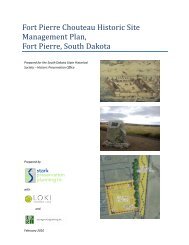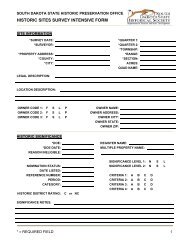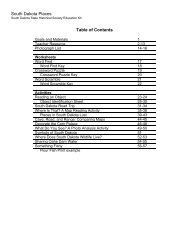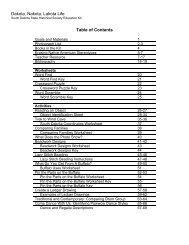The Blaine Site - South Dakota State Historical Society
The Blaine Site - South Dakota State Historical Society
The Blaine Site - South Dakota State Historical Society
Create successful ePaper yourself
Turn your PDF publications into a flip-book with our unique Google optimized e-Paper software.
3.2. PREVIOUS INVESTIGATIONS 23<br />
from about 1946 to 1969, was a period of continued exploration and description<br />
under the auspices of the Smithsonian Institution, culminating in attempts<br />
to develop new classification systems for the information collected or to apply<br />
classification systems that had been developed for other regions of the Great<br />
Plains. <strong>The</strong> third period of archaeological study of the Black Hills, beginning<br />
about 1971 and continuing to the present, comprised a large number of small<br />
projects conducted to satisfy the requirements of newly enacted federal and state<br />
cultural resource management regulations. <strong>The</strong> fourth and final period began<br />
around 1978 and also continues to the present. This was a period in which more<br />
problem-oriented approaches, as opposed to description and classification, were<br />
employed in archaeology projects in the area. This final period also saw the<br />
development of several studies that attempted to draw together the large bodies<br />
of information available about Black Hills archaeology into comprehensive<br />
statements about the prehistory of the area.<br />
<strong>The</strong> first archaeological explorations of the Black Hills were undertaken incidental<br />
to expeditions sponsored by the federal government and natural history<br />
museums to gather information about this relatively unexplored portion of the<br />
West. <strong>The</strong> Black Hills Expedition of 1874, led by George A. Custer, was purportedly<br />
undertaken to assess the natural resource potential of the Black Hills,<br />
which was Indian land at the time. In fact, the real purpose was to investigate<br />
rumors of rich gold deposits. In his report, the expedition naturalist, William<br />
Ludlow, mentions the presence of old campsites and trails in the vicinity of Red<br />
Canyon in the southern sector (Ludlow 1875). At the time, the government was<br />
mainly interested in these in reference to finding a militarily defensible trail into<br />
the interior Black Hills, and Ludlow made no attempt to establish when or by<br />
whom the remains were made.<br />
<strong>The</strong> next published mention of archaeological sites in the Black Hills is in a<br />
report on an archaeological reconnaissance of Wyoming undertaken by Harlan I.<br />
Smith in 1907–8 for the American Museum of Natural History (H. Smith 1908).<br />
Smith discovered a few sites on the western periphery of the Black Hills and<br />
concluded that the area probably had not been settled prior to the introduction<br />
of the horse. In this conclusion, Smith was following the conventional wisdom<br />
of the day which held that the Great Plains were uninhabitable until the horse<br />
was introduced to the region—a view that was to persist well into the present<br />
century (Wedel 1961).<br />
William H. Over, self-educated naturalist and director of the University of<br />
<strong>South</strong> <strong>Dakota</strong> (USD) Museum, conducted the first formal archaeological explorations<br />
into the interior Black Hills. Relying on the help and observations of<br />
local informants, Over identified prehistoric lithic quarries, rock art, and a possible<br />
village in the Black Hills (Over 1924, 1934, 1941, 1948). Also relying on<br />
local reports, E.B. Renaud of the University of Denver made brief mention of<br />
southern Black Hills sites in his reports on archaeological reconnaissance of the<br />
western plains (Renaud 1936). <strong>The</strong> following year, Renaud’s principal Black<br />
Hills informant published a short description of archaeological remains in the<br />
southern sector (Buker 1937).
















